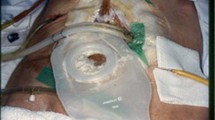Abstract
PURPOSE: The management of complex perianal fistulas with endorectal advancement flap is aimed at avoiding the risk of sphincter injury associated with traditional surgical methods. Long-term follow-up is required to assess the recurrence and continence outcomes of this procedure. The aim of this study was to review our experience with endorectal advancement flap in the treatment of complex perianal fistulas and to define the predictors of successful healing. METHODS: A retrospective chart review of all patients who underwent endorectal advancement flap for complex perianal fistulas between 1988 and 2000 was performed. Follow-up was established by telephone interview. RESULTS: One hundred six consecutive endorectal advancement flap procedures were performed on 94 patients (94.4 percent). There were 56 females (59.6 percent). Mean age was 41.6 (range, 18–76) years. Cryptoglandular disease was the most common cause of fistula (n = 41, 43.6 percent), followed by Crohn’s disease (n = 28, 29.8 percent). At a mean follow-up of 40.3 (range, 1–149) months, the procedure was successful in 56 (59.6 percent) of 94 patients. Twelve patients underwent repeat surgery with the same technique because of initial failure, 8 of whom eventually healed. Crohn’s disease was associated with a significantly higher recurrence rate (57.1 percent) when compared with fistulas in patients without Crohn’s disease (33.3 percent, P < 0.04). Prior attempts at repair of the fistula were not associated with less favorable outcome of the procedure (P = 0.5). Recurrence was not associated with the type of fistula, origin, preoperative steroid use, postoperative bowel confinement, use of postoperative antibiotics, or creation of a diverting stoma. The median time to recurrence was 8 (range, 1–156) weeks; there was no postoperative mortality. Two patients had postoperative bleeding, one requiring resuture of the flap on the first postoperative day. Recurrences were observed in 15.7 percent of the patients 3 or more years after the repair. In 8 patients (9 percent), continence deteriorated after the endorectal advancement flap, a more common finding in patients who had undergone previous surgical repairs (P < 0.02). CONCLUSION: The success rate of endorectal advancement flap for complex perianal fistulas is modest. Failure is mainly correlated with the presence of Crohn’s disease.
Similar content being viewed by others
Author information
Authors and Affiliations
Consortia
About this article
Cite this article
Mizrahi, N., Steven D. Wexner, M.D., Oded Zmora, M.D., Giovanna Da Silva, M.D., Jonathan Efron, M.D., Eric G. Weiss, M.D., Anthony M. Vernava III, M.D., Juan J. Nogueras, M.D.. Endorectal Advancement Flap. Dis Colon Rectum 45, 1616–1621 (2002). https://doi.org/10.1007/s10350-004-7248-z
Issue Date:
DOI: https://doi.org/10.1007/s10350-004-7248-z




